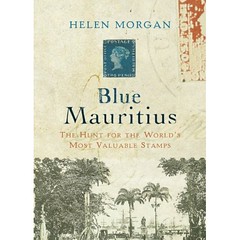
PREV ARTICLE
NEXT ARTICLE
FULL ISSUE
PREV FULL ISSUE
V11 2008 INDEX
E-SYLUM ARCHIVE
NEW BOOK: BLUE MAURITIUS - THE HUNT FOR THE WORLD'S MOST VALUABLE STAMPS
OK, it's not numismatic, but it may be of interest
nevertheless. Some of the numismatic books cover a single type of coin,
such as The Fantastic 1804 Dollar, the 1913 Liberty head Nickel and
1933 Double Eagle. A new book reviewed in last weekend's Wall Street
Journal covers the fascinating history of a single type of stamp - the
ultra rare "Blue Mauritius". -Editor
 How tough can it be to be king? If we take the
example of Britain's George V, the answer may be: not very. During his
reign (1910-36), George was known to spend about four hours a day with his
stamp collection. On royal tours, his lackeys let receiving heads of state
know that if they wanted to present the monarch with a gift, George would
gladly forgo the usual engraved salver in favor of a rare philatelic
specimen from Antigua or the Cape of Good Hope. In February 1908, when he
was still the Duke of York, George wrote to a friend regarding the
purchase of some stamps from Barbados: "Remember, I wish to have
the best collection, and not one of the best collections in
Britain."
How tough can it be to be king? If we take the
example of Britain's George V, the answer may be: not very. During his
reign (1910-36), George was known to spend about four hours a day with his
stamp collection. On royal tours, his lackeys let receiving heads of state
know that if they wanted to present the monarch with a gift, George would
gladly forgo the usual engraved salver in favor of a rare philatelic
specimen from Antigua or the Cape of Good Hope. In February 1908, when he
was still the Duke of York, George wrote to a friend regarding the
purchase of some stamps from Barbados: "Remember, I wish to have
the best collection, and not one of the best collections in
Britain."By then he was already well on his way, having acquired in 1904 -- for the unheard-of sum of 1,450 -- an essential component of any great stamp collection: the two-pence "Post Office" Blue Mauritius. As Helen Morgan writes in her enticing history of the little square of paper and the people who have pursued it, the Blue Mauritius was issued in 1847 by the then British-ruled island nation in the southwest Indian Ocean. Ms. Morgan notes that the stamp, of which 13 are known to exist, is a thousand times rarer than the famed Penny Black, the world's first adhesive stamp, issued in Britain in 1840.
The tale begins with the glamorous ball held in Port Louis, Mauritius, in 1847 by Lady Gomm, the wife of the island's British governor, Sir William Gomm. Not content with the prospect of a big party, she wanted special stamps to put on the admission cards sent to her invited guests. Thus was born the one-penny orange-red and the two-pence blue, establishing Mauritius as only the fifth country in the world to issue postage stamps.
 Ms. Morgan, an Australian, does not class herself
as a stamp collector, but she can proudly claim to be a philatelist --
that is, someone who cares a great deal about postal history. Her book,
which is as much travel memoir as detective story, was sparked by her
marriage to a Mauritian man and a trip to the island at the time of the
opening of a museum dedicated to the stamps.
Ms. Morgan, an Australian, does not class herself
as a stamp collector, but she can proudly claim to be a philatelist --
that is, someone who cares a great deal about postal history. Her book,
which is as much travel memoir as detective story, was sparked by her
marriage to a Mauritian man and a trip to the island at the time of the
opening of a museum dedicated to the stamps.She became enthralled by one story in particular, involving a French schoolboy who discovered, in 1902, one of the orange-red and two of the blue Mauritius stamps in the correspondence of a Bordeaux wine merchant. In 1993, one of the letters, bearing the orange-red and one of the blues side by side, was sold for $4 million, a philatelic record.
To read the complete article, see: Stamps of Wild Approval (http://online.wsj.com/article/SB121822908956325429.html)
Wayne Homren, Editor
The Numismatic Bibliomania Society is a non-profit organization promoting numismatic literature. See our web site at coinbooks.org.
To submit items for publication in The E-Sylum, write to the Editor at this address: whomren@gmail.com
To subscribe go to: https://my.binhost.com/lists/listinfo/esylum
All Rights Reserved.
NBS Home Page
Contact the NBS webmaster
